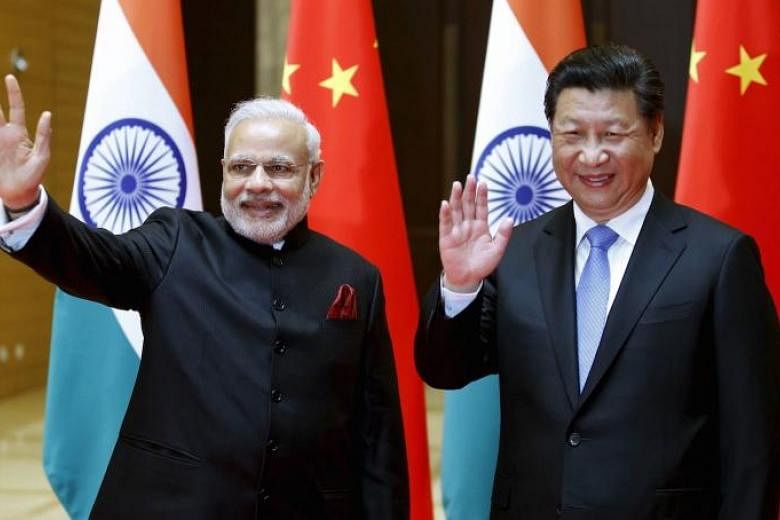BEIJING (CHINA DAILY/ASIA NEWS NETWORK) - US Secretary of Defence Lloyd Austin's visit to India last week, his first foreign visit after assuming office, was preceded by the first "Quad" summit.
Mr Austin's visit will be followed by British Prime Minister Boris Johnson's visit to India to herald the United Kingdom's post-Brexit foreign policy to be centred around the Indo-Pacific.
Together these events not just endorse but also reflect India's intensifying engagement with the United States-led Indo-Pacific strategy.
Among other issues, China-India border tensions in 2020 are cited as the reason for the accelerating drift in India's worldview which otherwise remains woven around its twin doctrines of "multi-alignment" and "strategic autonomy" - new forms of its historic nonalignment policy.
Understandably, these events have caused concerns among China's foreign policy analysts, especially among its India watchers.
However, recent Sino-Indian military disengagements on the border have raised hopes of India returning to its quintessential equilibrium in foreign policy.
Most aptly, this "return" to equilibrium is expected to be reflected in Chinese leader's much anticipated visit to India later this year to attend the BRICS summit.
Besides, with the novel coronavirus pandemic - which has claimed more than 2.72 million lives and triggered unprecedented anxieties across the world while also complicating Sino-Indian ties - beginning to recede, the new focus on vaccinations has revived the centrality of China's supply of active pharmaceutical ingredients to India and how China has contributed to India becoming the "pharmacy of the world".
Also, there are thousands of Indian students studying medicine in China and most of them are now gearing up to return to Chinese universities to continue their education and training.
As such, healthcare could become the next critical "connect" synergising post-pandemic China-India equations.
This is not, of course, to deny that post-pandemic China has emerged as a much stronger economic powerhouse, achieving 2.3 per cent growth in 2020, with its GDP now standing at a whopping US$15.5 trillion (S$20.8 trillion) while much of the world including the United States, the European Union member states, and India have experienced major economic contractions.
This has triggered new anxieties - about the China-led post-West-dominated world order arriving earlier than expected.
But despite these apprehensions, the reality of China's economic engagement remains far too deep and wide.
Even in 2020, despite the US-China trade tensions and mutual accusations, China's investment in the healthcare sector in the US showed an upward swing.
All this happened while previous US president Donald Trump continued issuing anti-China trade and investment policies till his very last day in office.
The Joe Biden administration, however, has already changed its tone and tenor. And the European allies of the US have remained more receptive to building economic partnerships with Beijing.
As for India, China remains the largest source of its imports and this is not likely to change anytime soon. Recent "post-disengagement" rethink on some of India's restrictions - that were placed on China's investments last year - has already resulted in the formation of a committee to review those restrictions that can be lifted or relaxed to allow smaller investments first.
India also banned hundreds of Chinese apps last year but these were largely symbolic with little economic bite although bilateral trade and investment did witness a shrink.
China remains deeply entrenched in India's e-commerce and pharmaceutical and chemical sectors, start-ups and select infrastructure projects. As engines of global growth, the two countries' bilateral economic cooperation should only deepen further.
Indeed, the whole world has begun to realise the limitations of last year's hype about decoupling from China-centric supply chains and expecting multinational companies to shift their production facilities out of China.
Some of this high-input, low-value added manufacturing was already being shifted to more cost effective destinations with lower cost of labour and business-friendly countries.
That was bound to happen with China's rising per capita income, its shift to high-tech sectors and pursuit of high-end technologies.
This reassessment of China is already reflected in the Biden administration seeking to reclaim global leadership by reviving the US' alliances and partnerships, including with Beijing.
This creates more familiar atmospherics for India's search for a post-border-tension "equilibrium" with China and to start their next chapter in confidence building to suit their changed global power profiles.
As their core commanders' disengagement talks move forward from Pangong Lake to Gogra-Hot Springs on the disputed Sino-Indian border - along with the regular oversight by their foreign ministries' Working Mechanism for Consultation and Coordination on India-China Border Affairs - China and India are inching closer to reviving their fascinating informal summits.
Something that was not publicised last year was how, as China and India went around the world providing healthcare support, neither side was seen undercutting the other's efforts.
This showed, once again, that the world is big enough to accommodate both the emerging Asian giants. With much of the developed world battered by the pandemic, it is time for the two neighbours to streamline their mutual equations to fulfil their historic mandate in crafting post-pandemic global resilience.
The author is a professor at and chairman of the Centre for International Politics, Organisation and Disarmament, Jawaharlal Nehru University, New Delhi. China Daily is a member of The Straits Times media partner Asia News Network, an alliance of 23 news media organisations.

